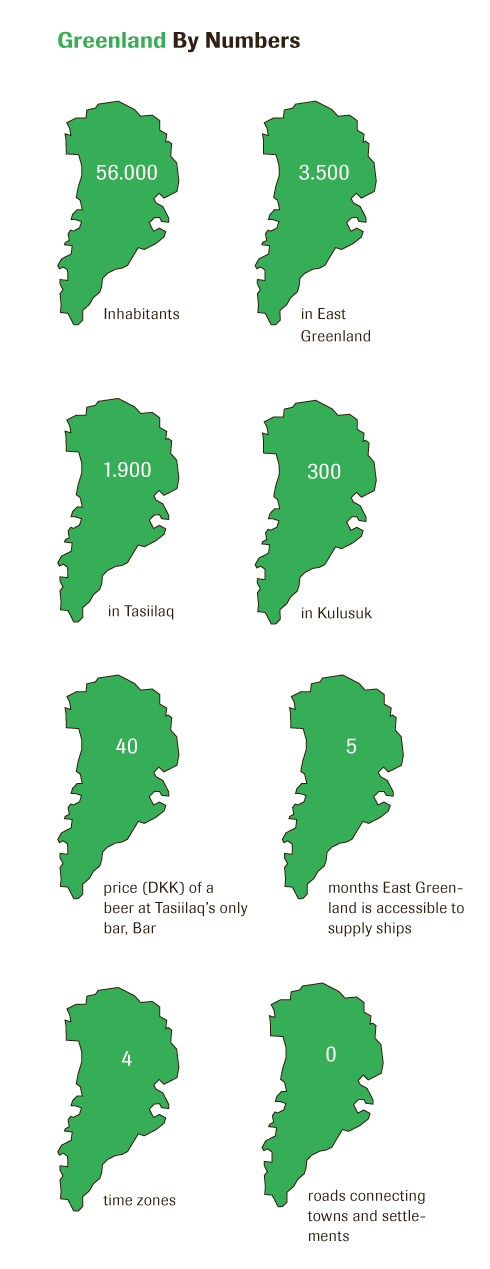
A rocky mass jutting out of an ocean full of icebergs revealed itself below the clouds as our plane began its descent into Kulusuk, East Greenland. The icebergs grew larger and larger in sight until our plane touched down on a small dirt runway. Only two hours earlier we were boarding the plane in Reykjavík, Iceland, after making a last minute dash for the bank to exchange our Icelandic krónur for Danish kroner.
To Greenland and back in time for dinner
Inside what must be one of the smaller international airports in the world, we met our guide, Jóhann Brandsson, an Icelander who has lived in Kulusuk with his wife and son full- or part-time since 1997. “There’s no need to change your clocks,” Jóhann said, holding his arm up above the group and gesturing to his wristwatch.
We would later find out that Greenlanders have a relatively detached relationship with time and engagements. “The only times that matter are 8 and 4,” Jóhann told us, “the opening and closing times at the Settlement House, where Kulusuk villagers meet to drink coffee, do their laundry and partake in workshops. Otherwise, it doesn’t matter.”
Nonetheless, for the group signed up on Air Iceland’s day trip to Kulusuk, it really did seem unnecessary to turn clocks back two hours only to turn them forward again later that evening. The trip, which departs from Reykjavík’s local airport at 10:10 am, returns again at 6:20pm, just in time for dinner. That is, if you are still hungry after the complimentary meal served on board.
Preserved through isolation
Jóhann proceeded to guide us into town, an idyllic 3-kilometer walk from the airport. To our right, snow capped mountains rose magnificently across the deep blue water. We were on a small island off the coast of the mainland. A lone construction truck drove past us on our left, kicking up a large cloud of dust above the dirt road. “We need rain soon,” Jóhann said. “It has been a very dry this summer.”
Before reaching town, we stopped at a small cemetery full of white crosses and graves well groomed with colourful plastic flowers. “You will notice there are no names on the graves,” Jóhann pointed out. “Greenlanders believe in what they call, ‘name-souls’. When someone dies, the name of the deceased is recycled as soon as possible and the soul then acts as a guardian to the newborn baring their name.”

Whereas West Greenland was colonized and Christianized more than 300 years ago, East Greenland, due to its inaccessible location, remained untouched until a little more than 100 years ago. As a result, Inuit traditions have been preserved to a greater extent in the east than in the west. Even today, supply ships cannot reach East Greenland except for five months of the year when the ice permits. When the first supply ship arrived on June 14 this year, East Greenland’s largest town, Tasiilaq, had been without soda, beer and wine for a month.
Seal for breakfast, lunch and dinner
From the top of the hill past the graveyard, a view of the town finally opened up before us—a picturesque assortment of green, yellow, blue and red wooden houses, where some 300 Greenlanders make their home. In the foreground, their small harbour was full of icebergs and motorboats.
Greenlanders are seal hunters. “They eat seal for breakfast, lunch and dinner, if they have to,” Jóhann told us. Traditionally, the seal is either boiled or dried and it can be seen hanging next to people’s houses around town. Yet, fast food has made it to the island and the town store was well stocked with the same goods you might find in a Danish grocery store.
The Danish influence is undeniable. Although in a recent referendum 75% of Greenlanders said they wanted independence from Denmark, Jóhann didn’t think it could happen. “Denmark heavily subsidizes the country, providing half the annual budget,” he explained.
The unemployment rate in Kulusuk is 70%, the biggest employers being the Kulusuk airport and hotel. “But, the figure doesn’t take into account those who go out and hunt seal for their families,” Jóhann reasoned. “Of course there are those who have given up and stopped hunting, but with nothing here, many are doing the best they can and some are doing quite well.”
Community, the key to survival
When we reached town, the tour broke up to allow for some free time. With so many people, so to speak, unemployed, there were few people hanging out about town. Yet, Jóhann told us that social integration is a central tenet of Greenlandic society. Families are important and an outcast member would not survive long.
We walked past one man feeding seal meat to his dogs. Greenlandic dogs are working dogs employed to pull snow sleds in the winter. They remain outside year round, working during the winter and when the snow melts in the summer, they are kept chained to the ground because snow sleds are of little use. To prevent the breed from losing its ability to withstand the arctic conditions, Greenland forbids dogs from being brought into the country.
To survive the imaginably harsh isolation of the arctic, it too only seems natural that Greenlanders have developed important mechanisms of survival, living in tightly knit families and sharing food, being one of them.
You are a lousy hunter and cannot support a wife
Reconvening with the group, Jóhann brought us to the edge of the water to see traditional kayaking and drum dancing. As we looked out onto the ocean, Kulusuk Mayor Pele Maratse came kayaking into view. “If he gains anymore weight, he will have to get a new kayak,” Jóhann joked. An Inuit invention, the traditional seal skin kayak is tailored to fit the individual. Even special anoraks were made to fit around the opening of the kayak to keep the kayaker dry. Today, the Greenlandic words “kayak” and “anorak” are borrowed in languages around the world.
Then, dressed in a traditional white anorak, sealskin boots, and beads, Anda Kuitse came before us to demonstrate traditional drum dancing. Drum dances served to entertain, heal and solve judicial disputes.
Grabbing an enthusiastic guest from the group, Anda demonstrated a judicial dispute. You wouldn’t have known it by the big grin plastered across his face, but he was delivering insult after insult in Greenlandic, such as, “you are a lousy hunter and cannot support a wife.” After the exchange, which might be compared to a modern day rap battle, the community decided who won the dispute.
And with that, the tour came to an end and everyone piled into small motorboats for a 15-minute ride back to the airport through the iceberg-laden waters. The boat ride costs an extra 30 DKK, but it is well worth it. And, when checking in to your flight, be sure to ask for a seat on the left side of the plane, (seats A and B), because you don’t want to miss the incredible view of Greenland as you fly off back to Reykjavik again.
—
Extending Your Stay
After the guided day tour, the Grapevine decided to spend a couple of extra days exploring East Greenland on our own. In addition to spending more time in Kulusuk, our adventures took us to Tasiilaq, which is a short helicopter or boat ride from the island of Kulusuk. The following is a small sample of what we did:
Kulusuk:
Hike in Kulusuk – There is a hike in Kulusuk, which leads you up to a cliff overlooking the Atlantic Ocean. It’s a nice 10 km walk each way, and Hotel Kulusuk offers rides if you are not much for walking. The view of icebergs, some of them poking through a layer of low-lying clouds, is spectacular.
Night at Hotel Kulusuk – Hotel Kulusuk provided us with a night’s stay in clean rooms and comfortable beds. Be sure to ask for a room with a view over the water. The hotel offers complimentary breakfast and serves lunch and dinner as well. Expect Danish cuisine.
Boat Ride to Tasiilaq – The best way to get to Tasiilaq from Kulusuk for a reasonable price is to find someone at the harbour who is heading that way. We happened to see Georg Utuaq walking with a couple girls carrying a tank of fuel and large coats, a sure sign they were on their way to sea. Lucky for us, they were going to Tasiilaq to do some shopping and Georg was happy to give us a lift in exchange for a few hundred crowns. We climbed into his small motorboat and, equipped with a compass and a GPS, he navigated with ease between the large and small icebergs standing in the way between Kulusuk and Tasiilaq. The trip is incredible. Be sure to dress warmly.
Tasiilaq:
Visit Ammassalik Museum – Museum Director Carl-Erik Holm gave us a wonderful run through of the history of East Greenland. When East Greenlanders first came into contact with the western world in 1885, they lived in turf houses and wore sealskin and face paint. In the last 100 years they have experienced a rapid modernization. Carl is also a great resource about life in East Greenland today, sharing titbits such as East Greenland ran out of soda, wine and beer a month before ice conditions allowed the supply ship make into the harbour on June 14 this year.
Dinner at The Red House – Finding Greenlandic cuisine is not simple. We were told the best way to try seal for example, is to ask the locals around town if they have any. Otherwise, there really isn’t a market for it on the street. Another way to experience Greenlandic cuisine is to eat dinner at The Red House. Robert Peroni, who runs the guesthouse and restaurant, uses Greenlandic ingredients purchased from the locals as much as possible, although he admits the cook tends to add a French or Italian flair. “Eating plain boiled seal meat day after day is not that exciting,” he told us matter of factly.
The fixed menu for the evening included Greenlandic winter mussels (small and salty), a halibut fish soup (creamy and delicious), minke whale bourguignon (not unlike beef bourguignon) and a raisin cake (I suppose there’s no such thing as a Greenlandic dessert).
Two thumbs up for this one. Trying the local cuisine is a must, Robert was very friendly, and everyone is provided with a comfortable pair of crocks to wear inside, which is just fun.
Have a drink at the bar, “Bar” – Getting a drink at Tasiilaq’s only bar is a good place to meet socially lubricated locals (as it is in any town). It wasn’t long before Sophie, a friendly Greenlander, waved to us from a couple of tables down and welcomed us to join her at a table with her friends.
Night at Hotel Angmassalik – Greenlandic brothers run Hotel Angmassalik and Hotel Kulusuk, and so it’s not surprising that the hotels are quite similar. This hotel sits on a hill overlooking the town, their soccer field, and the bay. The view is fantastic.
Talk to People – Greenland is called, “Kalaallit Nunaat” in Greenlandic, which translates to “Land of the People.” In our experience, Greenlandic and Danish locals were exceedingly friendly and interesting. So, the last piece of advice I leave is to get to know the people.
—
Due to a devastating server crash, we lost all the original images that appeared with this article in its original, printed form. If you find the replacement images disappointing, feel free to browse our .pdf arcives and search for the originals.
Buy subscriptions, t-shirts and more from our shop right here!
















